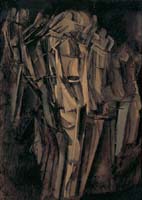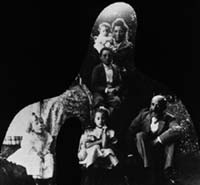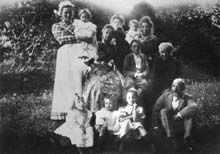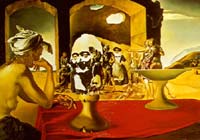| 1d. Two Brief Circular Digressions
Although the recursion theme is frequently linked to the Network's motif (we shall see in the next section another important example referred to as the Odyssey of Stoppages) we recognize its echo in other works along the whole artistic career of Duchamp. Here I want to discuss two further works, both referable to his biography; these works are emblematically placed at the opposite extremities of his artistic life: Sad Young Man on a Train (1911) (Fig. 24) and Family Portrait (1964) (Fig. 25). Sad Young Man on a Train is a self-portrait (where Duchamp represents two loved objects: the pipe and the walking stick). Let's read Duchamp's description:
The idea of a movement inside a movement is certainly recursive, and it is underlined by the alliteration of the original French title of the painting: Jeune homme triste dans un train. This alliteration (triste, train) is analyzed in an important article by Gould (2000)recalled extensively in the next section of this paper. Among other considerations, Gould wondered why the young man must be sad at all. He hypothesizes several answers. Here I shall resume two of them. The first cause of sadness is that the young man feels that his own motion adds only a scarce contribution to the overall motion of the train. This conjecture in turn leads me to a further conjecture. If we look at the motion inside the motion as an early intuition of a fractal idea, then the sadness of the young man would be related to the intuition of an important feature of fractals: the dimensional scaling. Thus, the sadness of the Young Man is similar to the one of Achilles, in Zeno's paradox, for his impossibility to reach the Turtle. The second cause of sadness is that in his motion the young man is twice bound (by both the binary and the corridor) to a linear pathway, which Duchamp feels is strongly limiting, so there seems to be the perception of the narrowness of the linearity; in fact, in the same year Duchamp introduced the important element of the circularity in the iterations for his work Young Man and Girl in Spring by means of the convective turbulence which we observed in a previous paragraph.
Let's now consider Family portrait, where we see the child Marcel together with his parents and little sisters. It is an old family photo (1899) (Fig. 26), which Duchamp cut along a strange curvilinear outline. We recognize an Arcimboldo-like technique, widely experimented also by Salvador Dalì (see for instance the famous Slave market with invisible apparition of Voltaire's bust (Fig. 27) or, even better, The Face of the War, both 1940): we see a human bust composed of several little human busts--recursion everywhere (and something which again recalls fractals). The mother's and Magdeleines' heads form the eyes, while Marcel's head is the mouth. Finally, Suzanne, Yvonne and the father Eugene form the arms and the thorax. Let's avoid for now the discussion about the meaning (not only psychological) of the exclusion of Marcel's brothers from this composition (we shall recall this important topic in a successive paragraph, because it requires the acquisition of new elements). Instead, let us confine ourselves to the formal consequences of this exclusion: we notice that the shape formed by the exclusion of a brother functionally constitutes the armpit's socket in the overall bust of busts, while the permanence of the second brother and of the other people present in the original photo would hamper the perception of the overall outline of the bust. Notice now that Duchamp obtained this readymade starting from a family photo (his own family). Thus, the recursion we noticed on the formal level is related on the content level to the cyclical recursion of the generation replacement, in which the sons become the new parents, who will have new sons, who will become new parents… Hence, we have the association between cyclicity and recursion; it is reinforced because the outline of the cutting no longer shows the rectilinear rigidity of the early self-portrait, but instead the smooth curves and roundness which Clair (2000) relates to those of a famous readymade: the Fountain (1917). A more detailed discussion about Clair's observation follows in subsequent paragraphs. Finally, if we look at the Family Portrait as Duchamp's phylogeny, then we could look at the early self-portrait of Sad Young Man on a Train as his ontogeny (after all this self-portrait isn't static, but instead a rather dynamic representation of his own temporal evolution). If so, we would recognize the implicit statement that both processes share the same recursive modalities. >>Next Figs.
24, 25
page 1 2 3 4 5 6 7 8 9 10 11 12 13 14 15 |
|||||||||||||||||
















